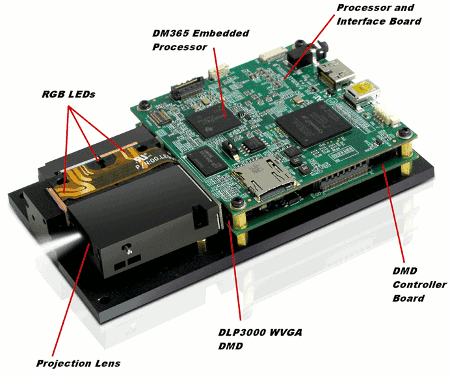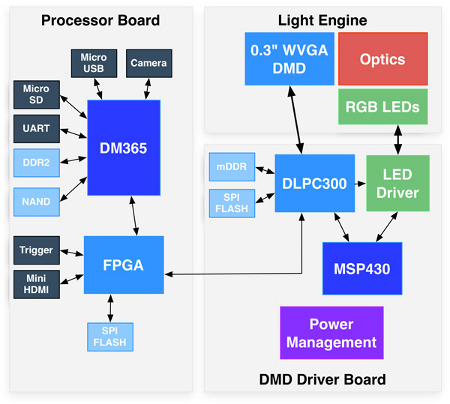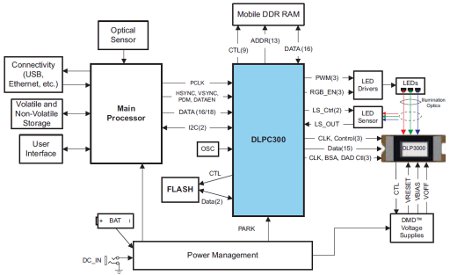TI ships Linux-ready DLP eval module for pico projectors
Jan 25, 2012 — by Eric Brown — from the LinuxDevices Archive — 666 viewsTexas Instruments announced a Linux-based evaluation module featuring the digital light processing technology from its DLP Pico Projectors. The DLP LightCrafter combines an ARM9-based, 300MHz DaVinci TMS320DM365 processor, a 20-lumen RGB LED light engine and projector, as well as TI's 0.3-inch, WVGA DLP chipset, enabling up to 4000 binary patterns per second, says TI.
The DLP LightCrafter evaluation module is intended to help develop DLP (digital light processing) devices for the industrial, medical, security and scientific instrument markets, says Texas Instruments (TI). Examples are said to include pico projectors, 3D fingerprint scanners, and other devices that require structured light pattern projection, intelligent lighting, wavelength selection, and portable display.

DLP LightCrafter
(Click to enlarge)
The DLP LightCrafter is built around TI's DLP 0.3 WVGA Chipset Reference Design (see block diagram below). The design's Linux firmware runs on TI's well-traveled DaVinci TMS320DM365 processor, which offers an ARM926EJ-S core clocked to 300MHz, as well as video accelerators and an ISP (image signal processor).

DLP 0.3 WVGA Chipset Reference Design block diagram
(Click to enlarge)
A "configurable I/O trigger" integrates cameras, optical sensors, and other peripheral devices, says the company.  These are said to include peripherals connected via the onboard micro-USB, mini-HDMI and UART interfaces.
These are said to include peripherals connected via the onboard micro-USB, mini-HDMI and UART interfaces.
On the DMD controller board underneath the processor board sits the the same DLP chipset found in the latest version of TI's Pico Projector, which first shipped back in 2009. With a native resolution of 684 x 608 pixels, it can display images up to 854 x 480 pixels (presumably using interpolation) and up to 4000 binary patterns per second, says the company.
The DLP chipset combines TI's DLP3000 MEMS device and DLPC300 controller. The MEMS device is comprised of 415,872 microscopic mirrors for high speed operation of the micromirror array, says TI.

DLP LightCrafter block diagram
(Click to enlarge)
Stated Mike Troy, CEO, FlashScan3D, "DLP technology allows us to capture greater detail in fingerprints with higher accuracy, thus cutting down on the possibilities of technician error and fraud, and with the new DLP LightCrafter development module, we can scan prints faster, store data internally versus on a laptop or separate storage device and, because of its size, create even smaller, portable products."
Availability
The DLP LightCrafter is available now, with a suggested retail price of $599, says TI. More information may be found at TI's DLP LightCrafter product page, as well as at SPIE Photonics West, held Jan.24-26, 2012 in San Francisco's Moscone Center, at booth #2415.
Eric Brown can be reached at [email protected].
This article was originally published on LinuxDevices.com and has been donated to the open source community by QuinStreet Inc. Please visit LinuxToday.com for up-to-date news and articles about Linux and open source.